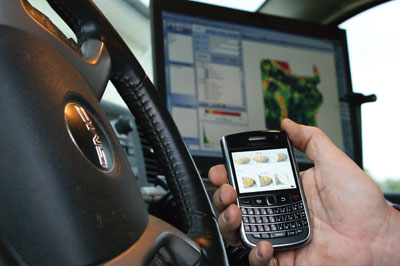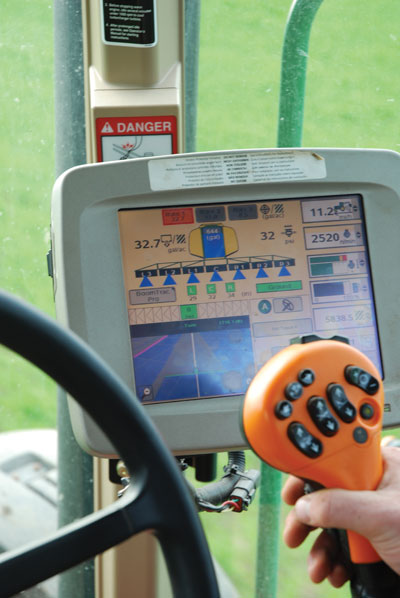
News
Reaping new ag technologies
Farming and technology are a natural fit.
December 1, 2011 By Treena Hein
Farming and technology are a natural fit. High-tech is making it easier than ever to achieve high yields and control disease and weeds at minimal cost, but it can definitely seem overwhelming at times. To increase a farmer’s comfort level and help reap the benefits of technology sooner, Karon Cowan of AgTech GIS in Embro, Ontario, offers this overview of where things are headed and important tips to keep in mind.
 |
|
| Not only has technology transformed information gathering systems inside the cab, but handheld technology is evolving at a phenomenal pace as well. Photo courtesy of John Dietz.
|
“Growers’ use of ag technologies has burgeoned in the last few years,” Cowan observes, “and the pace of acceptance and usage of hand-held and in-cab devices is set to explode. Farmers are familiar with basic GPS technology such as yield monitors and at this point, more of them are competent and/or willing to try new directions and new applications.”
Meanwhile, manufacturers are continuing to improve handheld and in-cab devices, making them more rugged and compact while offering more features in one piece of equipment. “More devices now offer tap-and-click ease of use,” says Cowan. “The new devices are also mostly touch screen, which offers users a very easy interface.”
At the same time, software programs are evolving quickly; more information is available for farmers to analyze, and the potential for farmers to be able to access an integrated, useful picture, a format where action can be taken immediately, is being realized. “I think the next five years will be incredibly exciting in terms of data from the field and equipment being put in the hands of the farmer and his or her service providers,” outlines Cowan.
She notes there are a number of mobile tools now available that can transmit data from the field through wireless transmission to the farm office computer or store data for download later. “Mobile tools can also remotely access office records,” she says. “All the data you need should be available to you, wherever you are on-farm.”
 |
|
|
As the accessibility of GPS and RTK technologies has expanded, so too have the services offered by most custom operators.
|
GPS systems that can provide guidance of six to 12 inches (what is commonly called sub-metre) have been around since 2001 or so, but Cowan says the big change came in about 2006 when these systems became more affordable, allowing operators of any size to capitalize on the advancements in technology. The consistency of performance became reliable, and government programs helped growers’ use of the systems become widespread. However, one of the most significant recent GPS advancements, in Cowan’s view, is the continuing expansion of RTK (real time kinematic) accuracy.
RTK had been reliant on “line of sight” signal corrections, which not only requires the costly creation of towers or other stations, but involves signals that degrade with increasing distance from the tower or are affected by obstructions or atmospheric interference. “Instead, RTK high-accuracy correction signals are being delivered via cell or internet connections,” Cowan notes. “RTK accuracies of one to two inches or better are becoming the standard.”
She adds that since 2009, more new farming equipment is making use of this higher accuracy for integrated auto-steering and other applications.
For a farmer who hires a company to do custom manure application, spraying and other tasks, there is no need to be concerned about integrating and using the data they provide. Cowan says there are already a large number of custom operators who have GPS guidance, steering, application control and monitoring systems on their equipment, and that those who do can provide a digital file as well as paper documentation (report and maps) of the job. Growers who do not have software ready to receive this type of file can access it for free from the brand used by their custom operator. “We offer Farm Works View as a free download from our website for instance,” notes Cowan. “If the grower later wishes to expand the capability, he can pay to turn this free viewer into a “live” program that has a full slate of information and map management tools, and all previously downloaded data are accessible.”
More points to keep in mind:
- Mixing and matching program and applications is perfectly fine.
- “Open standards have been developed so that devices made by different companies can communicate with each other,” notes Cowan. This means data collected by a Brand X planter monitor can be overlaid on Brand Y application maps with a Brand Z yield monitor and topped off with a scouting map from a handheld from another brand. “I can think at least 20 brands, all of which have incredible capability,” she says, “so pick and choose in each application what best fits your needs.”
- Buying technology is not a one-time purchase.
- “Technology is a continuum, with each development leapfrogging over the last,” notes Cowan. “Those growers who are truly making headway are those who stay current with the newest software versions and system upgrades.” She adds that the yearly “maintenance fee” or support program offered by vendors is a wise choice and provides great value.
- Put programs to full use.
- Cowan believes growers are still underusing the capability of onboard systems. “I worry that we’re still a bit dazzled by the shiny screens and amazing graphics and 3-D steering views,” she says. “It’s not about the visuals, and by now I’d hoped to see more information being collected going back into the office to be analyzed and mulled over and used.” She does, however, see a groundswell of motivation growing among farmers to move forward. “Farmers have all the tools they need to do their own variety trials or compare fertility programs or conduct any other management initiatives,” she asserts.
- Use all learning opportunities.
- Industry will be offering more and more opportunities to help operators become more proficient users of technology, and Cowan recommends taking advantage of any and all. “Attend seminars, soak up the tutorials on the program CD, go online, spend some time with someone who knows the ropes, and even, dare I say it, read the manual,” she advises.
- Dig in.
Cowan believes the greatest teacher of all is practice. “I encourage farmers to pick up a mouse whenever they finally let go of the steering wheel,” she says. “Ag decision-makers need to get their hands dirty with data. They need to look at their maps and reports and ask tons of questions.”